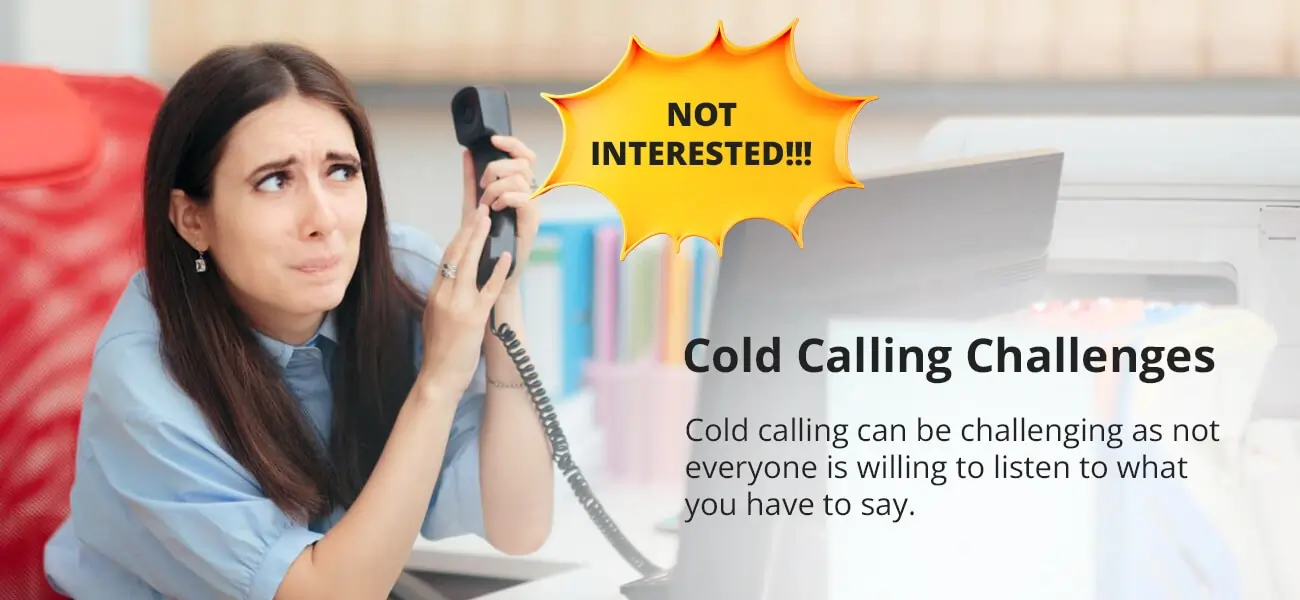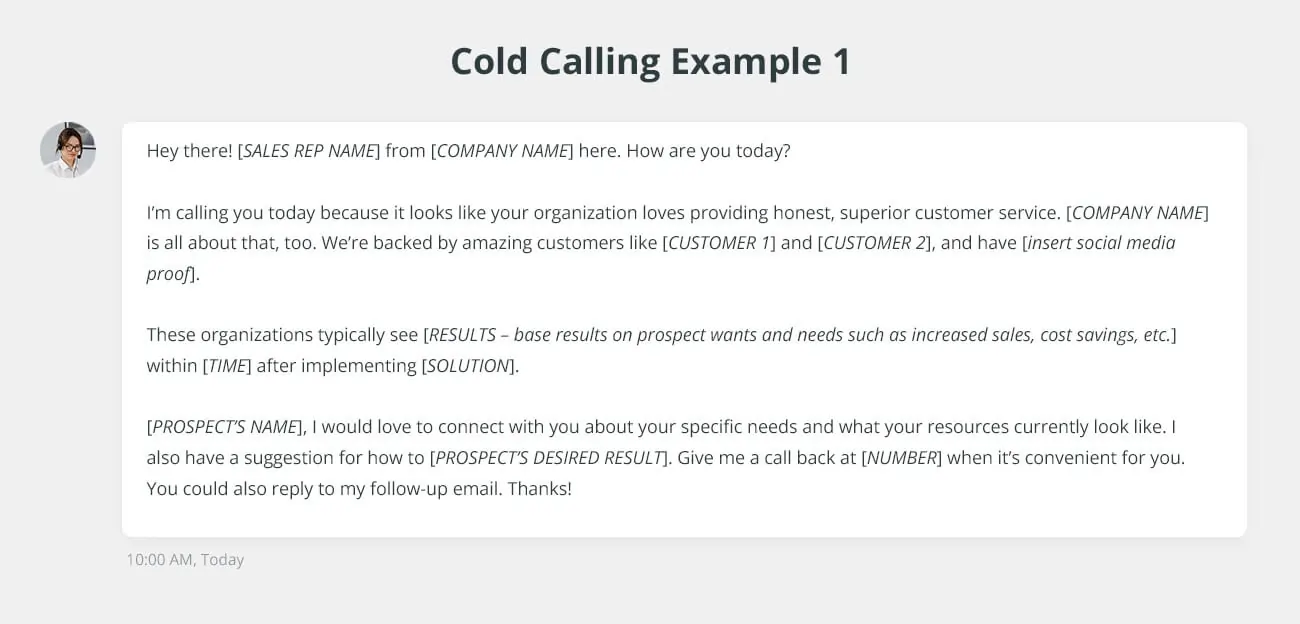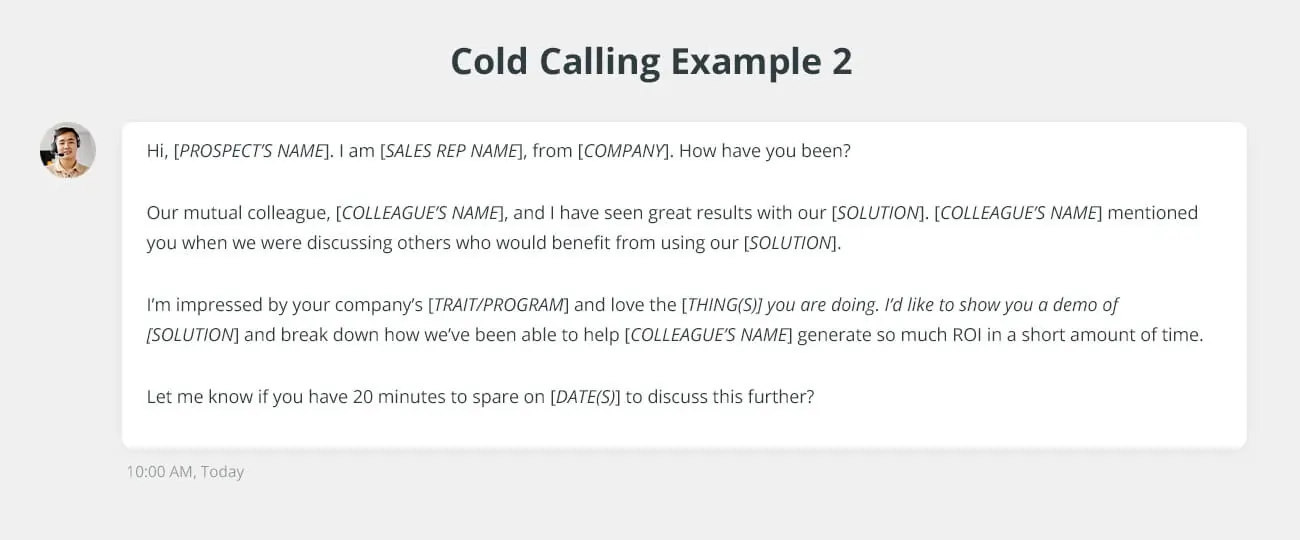Cold calling is when a business contacts potential customers or clients. These calls are unsolicited, as the receiver has no previous connection to the business.
Although cold calls have gained a bad reputation over the years, they are quite effective.
In this article, we will give you all the information you need to get a good understanding of cold calling.
With that said, let’s learn what it means to cold call someone.

What does cold calling mean?
Cold calling is a technique where salespeople make unsolicited phone calls or visits to potential customers. It is usually done to sell products or services to those who have never interacted with or are unaware of the company.
Cold calls can also be outsourced to call centers that have cold calling experts dedicated to this task.
The main purpose of a cold call is to get an appointment with the prospective buyer to discuss their needs and further steps. A majority of cold calls are unsuccessful. But they can improve your sales and brand awareness if done properly.
Challenges faced by cold callers
Recently, cold calling has become difficult. It is because many consider unknown numbers as spam or scams. Unfortunately, salespeople aren’t the only ones making cold calls. Very often, fraudsters and scam artists also make cold calls. It has further worsened people’s opinion of cold calling.
The Do Not Call Registry also makes cold calling new customers harder. It was introduced by the Federal Trade Commission and the Federal Communications Commission in 2003. The Registry allows customers to opt out of receiving cold calls for five years at a time. As of September 30, 2021, a little over 244 million active numbers were registered on the Do Not Call Registry.
Despite all the difficulties, cold calling is an effective way to get new customers. So, cold calling remains a vital part of the customer acquisition process.
So, how do you overcome these challenges and make successful cold calls?
Tips for successful cold calling
Timing- call during the “golden hours”
To succeed, you must carefully plan out your cold calling strategy. One way to ensure the effectiveness of your cold calls is to pick the best time to call your prospects.
According to Indeed, the best time to make cold calls is right before lunch or the end of the prospect’s workday. These would be between 10 and 11 a.m. and 4 and 5 p.m. The best days would be Wednesday and Thursday. These days tend to be more relaxed than the start and end of the workweek.
It doesn’t mean your sales team should sit idle in the downtime. All it means is that you have a higher chance of success if you call at these times. Your team has more to do than just make cold calls all day. Shift your salespeople’s focus to other tasks, like contacting existing clients (warm calling), in the downtime.
Moreover, merely calling at the right time doesn’t guarantee success. You must also consider other factors before you call the prospect.
Research- for a personalized approach
Personalization is the name of the game in cold calling. Research the prospect in advance and prepare a personalized sales pitch. Random cold calls are never effective and are a waste of time and effort. Put in the time and effort to familiarize yourself with the people on your call list before calling them.
Customize your offerings according to the individual’s needs, so you have a higher chance of conversion. Personalization will help your prospects stay engaged in the call. Your success rate will also improve.
So, what information will you need to personalize your cold calls?
Below are some crucial details to help you understand the prospects and plan a good cold calling strategy:
When calling a business-
- Recent news
- About the company
- Job openings
- Overlap of potential customers
- Mutual board members/investors (if any)
- Competitive analysis
When calling individuals-
- Professional background
- Job roles and responsibilities
- Recent career activity (like job changes or promotions)
- Mutual connections (if any)
- Education level
- Groups/ organizations they are part of
- Opinions, hobbies, and interests
Also, ensure that your information is up to date so you don’t seem unprepared during the call.
Prepare a cold calling script- sound more professional
A script will ensure you don’t miss important talking points during the call. It will also help you be more straightforward, so the prospect can understand your product or company with ease. With a script in hand, you will feel less nervous and sound more professional to the listener. It will allow you to be more confident when making the pitch.
Focus on the opening statement- make a good first impression
The first few seconds of a cold call are crucial for grabbing the listener’s attention. The prospect might disconnect the call if you cannot make a good impression. And there is no second chance at a first impression. Your cold call success relies a lot on your opener, as certain words or statements can trigger a harsh response.
So, take time to craft an opening statement to improve the effectiveness of your cold calls. Statements like “How are you?” or “How have you been?” have been shown to increase cold calling success rates. Opening your call by stating the purpose can also increase your chances of success. Conversely, begin the call with “did I catch you at a bad time?” makes you less likely to book a meeting with the prospect.
Interactive pitch- make your call a conversation
Turn your pitch into a dialogue with the prospect. Don’t focus on selling the product.
How do you make your cold calls interactive?
Ask them relevant questions, and frame your next question based on their responses. Allow the conversation to flow naturally.
Making your cold calls more interactive will help you:
- educate the prospects,
- find out about their problems,
- help them feel comfortable telling you about their business hurdles, and
- show them you are genuinely interested.
Get another meeting- if you can’t close in the first
Not all salespeople close deals in the first or even second meeting. Sometimes, it can take three or five meetings to complete a sale. As a matter of fact, 80% of sales are made during the fifth meeting. So, if you fail to make a conversion in the first few calls or meetings, don’t give up.
Trying to complete a sale in the first two or three discussions makes you appear “pushy”, shortsighted, or undisciplined. Play the long game and focus on convincing the prospect. Follow up with them to keep your company or product fresh in their minds. A less aggressive approach may make them more open to your pitch.
Successful cold calling strategies
Overcome the fear of rejection

Rejection is a part of all sales activities. People face the possibility of rejection in almost all parts of their lives. There is no escaping it. So, accept that rejection is unavoidable and try to get over your fear. You can overcome your fear by practicing your pitch with a friend or colleague or joking about your rejections.
Focus on learning rather than selling
Try to learn something new with each cold call. It is the best way to improve your cold calling skills. If you get rejected, don’t hesitate to ask the prospect why they don’t want your help. Feedback from the prospects can help you grow and improve your understanding of when to call, what to say, and what topics to avoid.
Know when to quit
If you have been making cold calls for a long time, you will know early into a call if a prospect is interested. You get a pretty good sense of which prospect has potential and which is a waste of your efforts. If it isn’t going anywhere, end the conversation, and move on to the next call. Prolonging a dead-end discussion is a waste of their time and yours.
Use the latest technology to avoid tedious tasks
Thanks to modern technology and the emergence of AI, you can automate many tedious sales activities. Such modernization can help salespeople focus solely on speaking to the prospect and getting them to convert.
Conduct thorough research and generate a list of targeted prospects
Carefully choose who you put on your list. Always add companies or individuals inclined to believe you can help them. Avoid contacting those who are not interested in what you have to offer. It will increase your chances of getting a positive response.
Avoid sounding robotic when reading scripts
Just reading the lines from your cold call script can make you sound robotic. Read your script as though you are an actor in a performance. Practice the script so the conversation sounds more natural.
Bear in mind that not everything will go as scripted. Each prospect is different and may not respond like the previous one. Each prospect will respond differently to different energies, vocabulary, and approaches. Improvise if you feel like you must do so to win over a prospect.
Schedule your calls effectively
People are more likely to engage with you when they are not working. Figure out the best time to call your prospects and call them at those times. It can be around lunchtime or when they are preparing to leave the office for the day. Put in your efforts at these times to get better cold calling results.
Focus on taking the prospect to the next step in the buying process
Cold calling is a marathon. The main goal is not to make a sale but to convince the prospect to move on to the next step in the buying process. When you cold call someone, they are usually unaware of your product. If you can get a prospect to set up a follow-up appointment after your initial cold call, then you have succeeded.
Leave effective voicemails
As a salesperson, you may not always get to speak to the prospect on the first try. You will get voicemail more often than the prospect.
So, how do you make an effective pitch when you aren’t speaking directly to the prospect?
You will need to figure out how to grab their attention. Your goal in cold calling is to make the prospect interested in your product, not to immediately sell it to them. Decide what you want them to learn from your voicemail. Then, deliver one message per voicemail, so you don’t leave one long, rambling message.
Delivering one message at a time will also help if you need to leave multiple voicemails. It won’t sound like you are repeating the same points.
Here are some tips to help you leave a good voicemail:
Dos
- Keep it under 20 seconds
- Use a friendly, upbeat tone
- Add a sense of urgency
- Use your and your prospect’s names
Don’ts
- Try to sell
- Sound desperate
- Leave only one voicemail
Examples of what good cold calls look like
Curious as to what a good cold call looks like? Here are some examples to help you improve your cold calling success rates.
Example 1:
Example 2:
The bottom line
Cold calling is a tough but necessary part of sales. Most cold calls end in disappointment, as many sales reps give up too soon. The key to a successful cold call is to know your targets before you plan a personalized message and try to have a conversation. At the end of the day, the goal of cold calling is not to sell but to ensure that the prospect moves on to the next step in the buying process.






